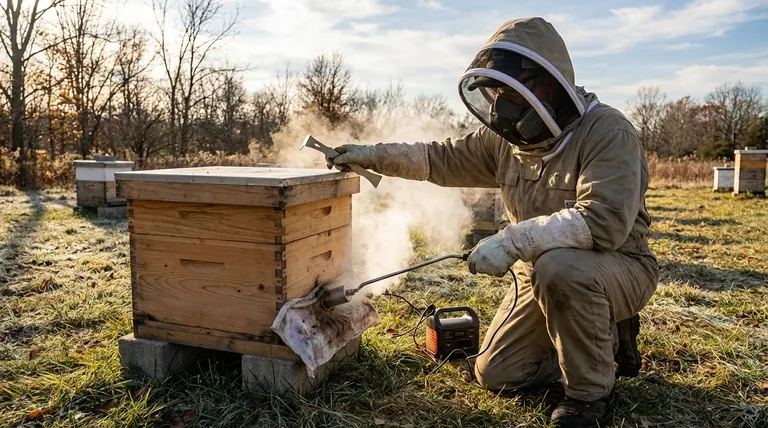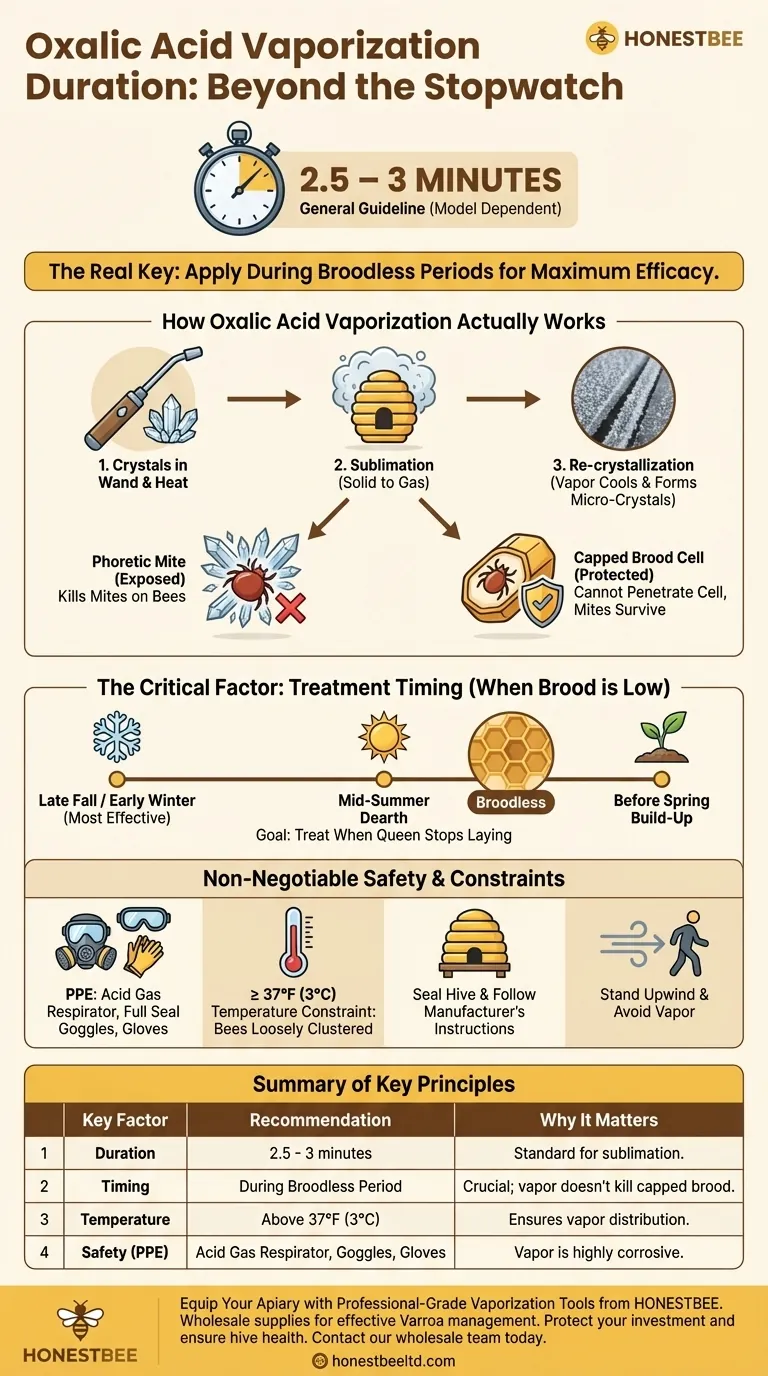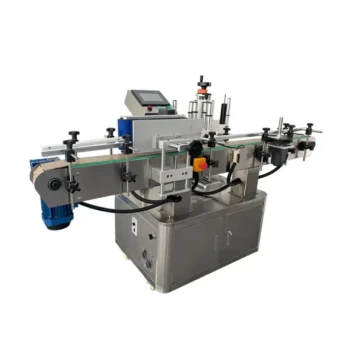In short, the recommended duration for oxalic acid vaporization is 2.5 to 3 minutes. This timeframe, however, is dependent on your specific vaporizer model and its power source. Achieving an effective treatment is less about the stopwatch and more about understanding the principles of timing, temperature, and safety that make this method work.
The core principle of oxalic acid vaporization is not just about the duration of the treatment, but about applying it when it can be most effective: during a broodless period in the hive. Because the vapor cannot penetrate capped brood cells, proper timing is the single most important factor for success.

How Oxalic Acid Vaporization Actually Works
To use the tool effectively, you must first understand the mechanism. The process is more nuanced than simply "fogging" the hive.
From Crystal to Vapor
The treatment begins with a measured dose of oxalic acid dihydrate crystals placed in the heating element of a specialized vaporizer wand. When heated, these crystals sublimate—turning directly from a solid into a gas.
The Re-crystallization Effect
This hot vapor fills the hive cavity. As it cools, it re-crystallizes, forming a micro-fine layer of sharp oxalic acid crystals over every surface inside the hive, including the bees themselves.
Why This Kills Mites
These microscopic crystals are lethal to Varroa mites on contact. The treatment is effective against phoretic mites—those riding on adult bees. It has no effect on mites reproducing within the safety of a capped brood cell, which is the fundamental limitation of this method.
The Critical Factor: Treatment Timing
Because the treatment only kills exposed mites, when you treat is more important than almost any other variable. Your goal is to treat when the mite population is most vulnerable.
The Principle of Broodless Periods
The ideal time for an oxalic acid treatment is when the queen has stopped laying or the brood nest is at its smallest. With no capped cells to hide in, the vast majority of the hive's mites will be phoretic and exposed to the treatment.
Ideal Treatment Windows
Beekeepers have identified key moments in the year when brood is naturally low:
- Late Fall or Early Winter: This is the most effective time, as a cold snap often causes a complete break in the brood cycle.
- Mid to Late Summer: In some climates, a summer nectar dearth can cause the queen to reduce her laying rate.
- Before Spring Build-Up: A treatment can be performed before the first honey supers are added, catching mites before the population explodes with the growing brood nest.
The Temperature Constraint
Oxalic acid vaporization should only be performed when the outside air temperature is at least 37°F (3°C). This ensures the bees are loosely clustered, allowing for better vapor distribution throughout the hive.
Understanding the Trade-offs and Risks
While highly effective when used correctly, vaporization has clear limitations and requires careful execution.
Ineffectiveness on Capped Brood
This is the primary trade-off. If you treat a hive with a large, active brood nest, you will only kill a fraction of the total mite population. The treatment will appear to have worked based on the initial mite drop, but a new wave of mites will emerge with the hatching brood.
The Importance of Sealing the Hive
For the 2-3 minute duration, the vapor must be contained. You must seal the hive entrance with a damp cloth and close off any screened bottom boards to ensure the vapor concentrates properly and has time to re-crystallize on all surfaces.
Equipment and Dosage Variance
The 2.5 to 3-minute guideline is a general rule. Always follow the specific instructions for your vaporizer regarding both the duration of heating and the correct dosage of oxalic acid crystals (typically 1 gram per brood chamber).
Your Safety is Non-Negotiable
Oxalic acid vapor is highly corrosive and dangerous to your respiratory system. You must handle it with the same respect as any other hazardous material.
Essential Personal Protective Equipment (PPE)
Do not perform a treatment without, at a minimum, a properly rated acid gas respirator. An N95 dust mask is insufficient. Full-seal goggles and acid-resistant gloves are also critical to protect your eyes and skin.
Mind Your Position
Always stand upwind from the hive during application. This ensures that any vapor that leaks from the hive entrance or other gaps is blown away from you, not towards you.
Follow the Label
Oxalic acid is a registered pesticide for controlling Varroa mites. The product label is a legal document. Read and follow all instructions and safety warnings provided with the specific oxalic acid product you are using.
Making the Right Choice for Your Goal
Apply these principles to your specific beekeeping objectives.
- If your primary focus is a high-efficacy knockout treatment: Perform the vaporization during a confirmed broodless period in late fall or early winter for the highest mite kill rate.
- If your primary focus is managing mite loads during the season: Use vaporization when brood is naturally lower, but understand it will be less effective and may require follow-up monitoring or treatment.
- If your primary focus is safety and consistency: Always wear your full PPE, meticulously follow your equipment's instructions for dosage and duration, and seal the hive properly for every treatment.
By understanding the principles behind the process, you can confidently use oxalic acid vaporization as a powerful tool for maintaining hive health.
Summary Table:
| Key Factor | Recommendation | Why It Matters |
|---|---|---|
| Duration | 2.5 - 3 minutes | Standard for most vaporizers to sublimate crystals effectively. |
| Timing | During a broodless period | Vapor cannot penetrate capped brood cells; timing is critical for success. |
| Temperature | Above 37°F (3°C) | Ensures bees are loosely clustered for proper vapor distribution. |
| Safety (PPE) | Acid gas respirator, goggles, gloves | Oxalic acid vapor is corrosive and hazardous to respiratory systems. |
Equip Your Apiary with Professional-Grade Vaporization Tools from HONESTBEE
For commercial apiaries and beekeeping equipment distributors, precise and reliable tools are non-negotiable for effective Varroa mite management. HONESTBEE supplies wholesale beekeeping supplies and equipment, including robust oxalic acid vaporizers designed for heavy use and consistent performance.
Let us help you protect your investment and ensure hive health with equipment you can trust. Contact our wholesale team today to discuss your apiary's needs.
Visual Guide

Related Products
- HONESTBEE Advanced Ergonomic Stainless Steel Hive Tool for Beekeeping
- Queen Bee Artificial Insemination Instrument Equipment for Instrumental Insemination
- Stainless Steel Bee Hive Smoker Beekeeping Smoker for Wholesale
- Stainless Steel Electric Beehive Smoker for Beekeeping and Bee Keeper Use
- European Stainless Steel Bee Smoker for Honey Bee Hive
People Also Ask
- Why is it important to compare the progress of different hives? A Beekeeper's Key Diagnostic Tool
- Why do hive tools have a hole? Unlock the Secret to Efficient Beekeeping
- What tools are used for cleaning frames? A Beekeeper's Simple 4-Tool Guide
- What are the basic tools for beekeeping? Essential Starter Kit for Safe & Successful Hive Management
- What is the hole in a hive tool for? A Multi-Tool for Apiary Repairs and Maintenance



















